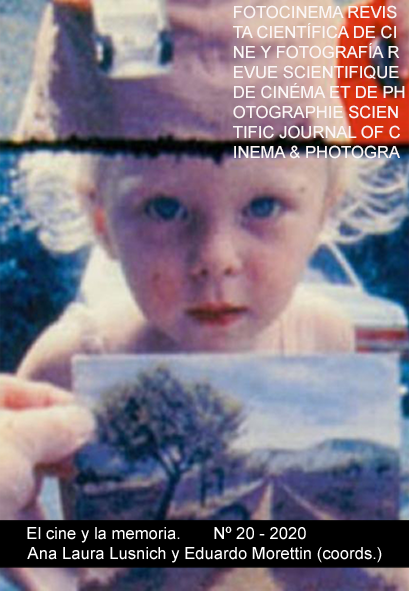Pablo Berger's Torremolinos 73: A Post-Modern Look at Late-Franco Spain
DOI:
https://doi.org/10.24310/Fotocinema.2020.v0i20.7591Keywords:
Torremolinos 73, Pablo Berger, memory, postmodernity, deformationAbstract
In 2003 Pablo Berger released his first feature film, Torremolinos 73, a comedy set in late-Franco Spain. This film is the cinematographic transposition of the authentic itinerary of an aspiring Spanish filmmaker of the 1970s, author of a pornographic film that ended up being marketed in Denmark. The temporal context in which the protagonist's story takes place is a pretext for recreating a pre-democratic era from which Berger preserves above all consumer culture, making the film the place of a popular memory. The aim of this work is to examine how the film director appropriates the fragments of an essentially mediatic memory, voluntarily excluding any historical or open political discourse, in order to offer a stylized, atomized and distorted representation of the period re-imagined in a postmodern way. The recycling of musical and cinematographic references is governed by strategies of deformation and parodic rewriting that fully inscribe Berger's film in Spanish postmodern cinema, while the abysmal construction of the film produces a self-reflexive discourse on the seventh art and its creative mechanisms in the director's own work.
Downloads
Metrics
Publication Facts
Reviewer profiles N/A
Author statements
Indexed in
-
—
- Academic society
- N/A
- Publisher
- Universidad de Málaga
References
Aumont, J. (2003). Ingmar Bergman. “Mes films sont l’explicitation de mes images”. Cahiers du cinéma, 116-117.
Bracco, D. (2015). El hechizo de las imágenes: Blancanieves, el cuento espectacular de Pablo Berger (2012). Fotocinema. Revista científica de cine y fotografía, 11, 26-49. Disponible: http://www.revistafotocinema.com/ DOI: http://dx.doi.org/10.24310/Fotocinema.2015.v0i11.6074
Brémard, B. (2006). L’image de la dictature dans le feuilleton Cuéntame cómo pasó. En Seguin, J.-C. y Amiot, J. (eds). Image et Pouvoir (pp. 601-609). Lyon: Grimh.
Brémard, B. (2008). Cuéntame la crónica de tiempos revueltos: experimentar la verdad histórica mediante la ficción televisiva. Trama y Fondo. N ° 24, primer semestre, 141-149.
Castro de Paz, J. L., Pérez Perucha, J. y Zunzunegui, S. (dir.) (2005). La nueva memoria. Historia(s) del cine español (1939-2000). A Coruña: Vía Láctea.
Feenstra, P. (dir.) (2009). Mémoire du cinéma espagnol (1975-2007). Condé-sur-Noireau: Corlet Publications, col. “CinémAction”, n° 130.
Fraile Prieto, T. (2014). Nostalgia, revival y músicas populares en el último cine español. Quaderns de cine, 9, 107-114. Disponible https://revistes.ua.es/quacine/article/view/2014-n9-nostalgia-revival-y-musicas-populares-en-el-ultimo-cine-espanol
DOI: https://doi.org/10.14198/QdCINE.2014.9.12
Grandgeorge, E. (1992). Le Septième Sceau. Étude critique. [s.l.]: Nathan, col. “Sinopsis”.
Hutcheon, L. (1985). A Theory of Parody: The Teaching of Twentieth-Century Art Forms. New York / London: Methuen.
Hutcheon, L. (2002). The Politics of Postmodernism (1989). London / New York: Routledge.
Jameson, F. (2007). Le Postmodernisme ou la logique culturelle du capitalisme tardif (1991). Paris: Beaux-Arts de Paris, col. “D’art en questions” (trad. Florence Nevoltry).
Jullier, L. (1997). L’Écran postmoderne : un cinéma de l’allusion et du feu d’artifice. Paris: L’Harmattan.
Kowalsky, D. (2007). Cine nacional non grato. La pornografía española en la Transición (1975-1982). En Berthier, N. y Seguin, J.-C. (dir.). Cine nación, y nacionalidad(es) en España (pp. 203-214), actes du colloque international des 12-14 juin 2006. Madrid: Collection de la Casa de Velázquez, vol. 100.
Navarrete Cardero, J. L. (2009). Historia de un género cinematográfico: la españolada. [s. l.]: Quiasmo.
Pohl, B. (2005). El Postboom en España (1973-1985). Intercambio cultural y mercado del libro. En López de Abiada, J. M. y Morales Saravia, J. (eds). Boom y Postboom desde el nuevo siglo: impacto y recepción (pp. 208-247). Madrid: Verbum.
Pohl, B. y Türschmann, J. (eds.) (2007). Miradas glocales. Cine español en el cambio de milenio. Madrid / Francfurt: Iberocamericana / Vervuet.
Pohl, B. (2009). Mémoire vivante, mémoire médiatisée ? Le recyclage des années 1970. En Feenstra, P. (dir.). Mémoire du cinéma espagnol (1975-2002) (pp. 116-122). Condé-sur-Noireau: Corlet Publications, col. “CinémAction”, n° 130.
Rueda Laffond, J. C. y Guerra Gómez, A. (2009). Televisión y nostalgia. The Wonder Years y Cuéntame cómo pasó. Revista Latina de Comunicación Social, n° 64. Disponible: http://www.revistalatinacs.org/09/art/32_831_55_Complutense/Rueda_y_Guerra.html
Sánchez-Biosca, V. (2001). Le recyclage de l’Histoire dans la comédie espagnole des années 90. En Murcia, C. y Thibaudeau, P. (dir.). Cinéma espagnol des années 90 (pp. 71-80). Poitiers: La Licorne, UFR Langues Littératures Poitiers, Maison des Sciences de l’Homme et de la Société.
Sánchez-Biosca, V. (2006). Cine de historia, cine de memoria. Madrid: Cátedra.
Sánchez-Biosca, V. y Benet, V. J. (dir.) (2010). Les Enjeux du cinéma espagnol: de la guerre à la postmodernité. Paris: L’Harmattan, col. Horizons Espagne.
Downloads
Published
How to Cite
Issue
Section
License
All contents published in Fotocinema Revista científica de cine y fotografía are protected under the Creative Commons Attribution-NonCommercial-ShareAlike 4.0 International (CC BY-NC-SA 4.0) license. All about this license is available in the following link: <http://creativecommons.org/licenses/by-nc-sa/4.0>
Users can copy, use, redistribute, share and exhibit publicly as long as:
- The original source and authorship of the material are cited (Journal, Publisher and URL of the work).
- It is not used for comercial purposes.
- The existence of the license and its especifications are mentioned.
There are two sets of authors’ rights: moral and property rights. Moral rights are perpetual prerogatives, unrenounceable, not-transferable, unalienable, imprescriptible and inembargable. According to authors’ rights legislation, Fotocinema. Revista científica de cine y fotografía recognizes and respects authors moral rights, as well as the ownership of property rights, which will be transferred to University of Malaga in open access. The property rights are referred to the benefits that are gained by the use or the dissemination of works. Fotocinema. Revista científica de cine y fotografía is published in an open access form and it is exclusively licenced by any means for doing or authorising distribution, dissemination, reproduction, , adaptation, translation or arrangement of works.
Authors are responsable for obtaining the necessary permission to use copyrighted images.














13.png)



